History of Sextupole Calibration Runs
and
Voltages Measured on 9/23/2003
Analysis of Data Taken 10/28/2002, 9/17/2003 and 9/28/2003
3 October 2003
JAC
The beam-based calibration of the 76 sextupole magnets proceeds by
bumping the beam (t1.b1. positrons) in each sextupole and measuring
the horizontal and vertical tune change for two settings of the
sextupole strength. The program which does this is
[cesr.dcs.sext]sex_multipole.exe.
A complete run takes about 90 minutes, if there
are no interruptions. The present version of the program does no
sweeping of either the bump setting or the sextupole setting to
avoid hysterisis effects.
User-controlled parameters of the calibration
run are the choice of which sextupoles to calibrate, the range over
which the sextupole current is varied and a limit on the maximum
tune excursion. The latter can be important to avoid crossing resonances
during the calibration. For example, the conditions of 9/17/03 and 9/28/03
had a horizontal synchrobetatron resonance at 213 kHz. So before running the
the horizontal tune was moved to 220 kHz and the
tune change limited to 5 kHz. Restricting the current range of the sextupole
can also help to avoid beam loss during the calibration.
Phase measurements can be used by the program which analyzes the raw
calibration data ([cesr.dcs.sext]anal_sex_multipole.exe)
to improve the accuracy of the calibration
by providing more accurate calculation of the beta function (as opposed
to assuming the design value.) The phase measurement must be
taken just prior to the calibration run, and CESRV is then used to
produce a digested file for use by the analysis program.
The three calibration runs presented here have the following characteristics:
-
1) 10/28/2002
Beam energy Upsilon 2S (5.012 GeV). CSR save set 86287. Range +-1000 cu.
-
2) 9/17/2003
1.9 GeV. Range +-500 cu. CSR save set 91896. The sextupole currents were those of the design lattice. Sextupole number 85 (14E) was was
wired backward during this calibration, as shown by its calibration
factor of approximately -1.
-
3) 9/28/2003
1.9 GeV. Range +-250 cu. CSR save set 92264. No phase measurement was available for this data. The sextupole currents were those optimized on positron injection. Despite the restricted range of sextupole current used
for the calibration, the beam was lost quite a few times during this calibration run, resulting in missing calibration data for some sextupoles.
All of these tune measurements were done using the faster tune measurement algorithm (see 9/22/2003), which is known to be problematic at 1.9 GeV.
On 9/23/2003 the voltages across all the sextupoles were measured for
a uniform set value of 1000 cu. The distribution of these values
show that the power supply fluctuations are about 2.5% rms.
Subsequent investigation of a few power supplies which exhibited the most anomalous voltage values showed that these did not exhibit similarly anomalous current values.
The variation
in the beam-based measurements of 10-20% show that accuracy of the measurement method itself dominates the results.
Suggestions for improving this calibration procedure are:
-
Use slower, more accurate tune measurement algorithm
as implemented in XIMES on 9/22/2003 (done 10/3/2003 by DCS)
-
Sweep through bump settings to avoid hysterisis effects. Make sure
the bump is zeroed after use.
-
Sweep through sextupole current settings to avoid hysterisis effects.
-
Include a correction for the tune change due to chromaticity, since the
introduction of bumps changes the orbit and hence the path length.
Such a correction may not be easy, since the chromaticity may not
be well known or easily measurable.
-
Measure the sextupole strength by varying the RF and using the dispersion
to create displacement in the sextupoles, rather than using the
hysterisis-plagued bump method.
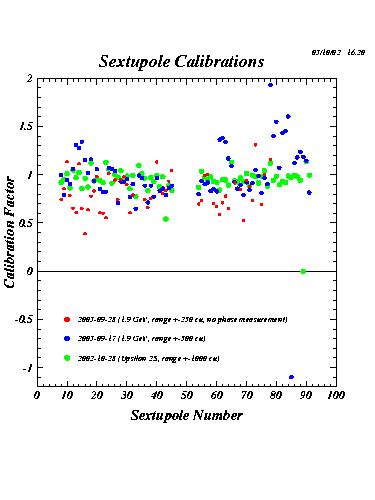
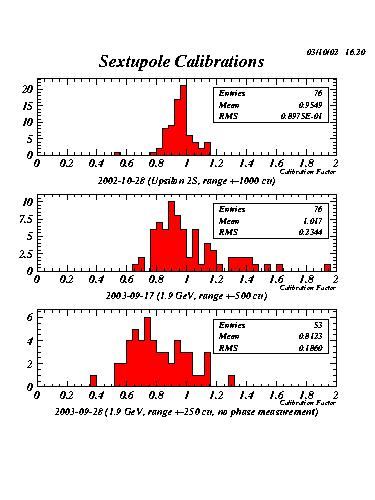
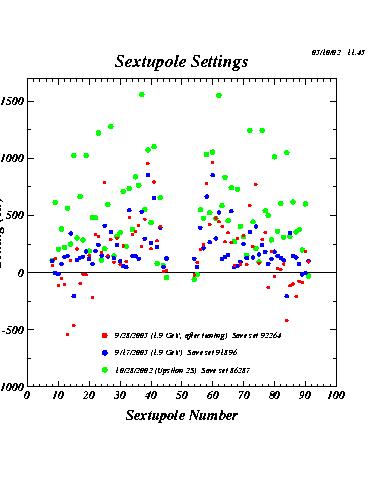
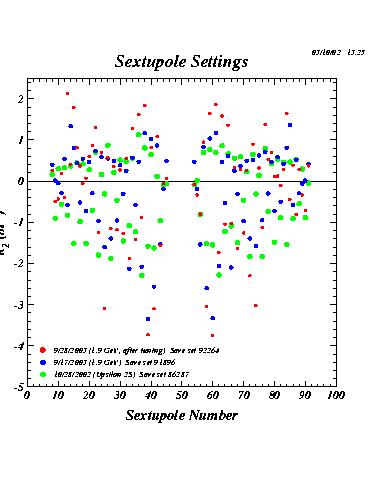
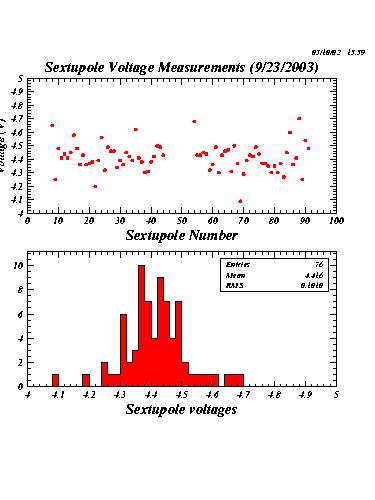
Creation date: 10/06/03.




